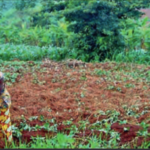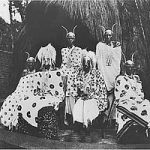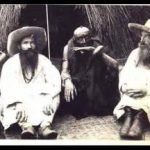The 1960 Commune Elections
On a national level the commune elections of 1960 marked an important gain for Hutu. The elections were to select burgomasters and councilors for the newly created communes -administrative entities designed to replace existing subchiefdoms (restructured into larger units) and chiefdoms (provinces), which were to be abolished. The Hutu parties, especially PARMEHUTU, won an overwhelming victory at the polls, with 83.8 percent of the vote. Hutu parties won a majority of the votes in 211 of the 229 communes, and of the 2896 councilors elected, 2623 were candidates of Hutu parties. The results of these elections demonstrated widespread support for the Hutu leadership and program. The victory at the polls also placed Hutu leaders in critically important positions; henceforth they could exercise control over key resources, and engage in daily contact with the population.
In Kinyaga, a core of some fifteen APROSOMA adherents began organizing among the local population during the early months of 196o. These Hutu held a number of meetings, planning organizational strategies and preparing for the upcoming commune elections. The leaders developed a friendly rapport with the Belgian Territorial Administrator at Cyangugu, who apparently gave them moral and even some organizational support. As the emphasis of the administration shifted from a primary concern with effective administration under colonial ride to a desire to leave an honorable legacy of an independent country, individual sympathies also adjusted to these new perspectives, and many administrators, led by Special Resident Logiest, proffered support to the majority ethnic group.
Such help was particularly important given the open Tuutsi (UNAR) efforts at intimidation of Hutu who attempted to explain the meaning of thee elections to the population. For example, several Hutu traders with shops at Bushenge market near Shangi were attacked and their shops looted – a punishment for their activities in support of the Hutu parties. As a result of such challenges, Hutu leaders at times found it necessary to hold clandestine meetings in the forest, so that they would not be perceived by the chiefs.
Party organization in Kinyaga had been initiated by Aloys Munyangaju, under the aegis of APROSOMA. As we have noted, this party called for social and economic changes to help all disadvantaged groups in Rwanda, not just Hutu. Although in the majority comprised of Hutu, APROSOMA initially welcomed Tuutsi who shared its goals of working for social and political changes and an end to the arbitrary power of the chiefs. PARMEHUTU, which did not commence activities in Kinyaga until May 1960, espoused a more frankly radical ethnic ideology than APROSOMA, ruling out the possibility of cooperation with Tuutsi. As we have seen, Kayibanda focused the initial organizational efforts of PARMEHUTU around Gitarama in the center of the country and in the northern regions of Ruhengeri–Gisenyi. APROSOMA activities were centered principally at Astrida (now Butare), under the leadership of Gitera, and in Kinyaga. When PARMEHUTU commenced activities in Kinyaga in May 196o, the party gained adherents in some areas from among APROSOMA supporters. As one Belgian administrator commented at the time, “A virulent APROSOMA [member] becomes PARMEHUTU.
Many of the Kinyagan Hutu who played leading roles in early protest activities were men who had mobility (they were often truckdrivers or traders), access to instruments for communication (e.g., printing presses or mimeograph machines in Bukavu for putting out circulars and party membership cards), and an acquaintance with ideas of organizing which they used to mobilize protest. And some of the local Hutu leaders were schoolteachers or catechists who enjoyed a wide network of local ties and prestige associated with their work. Often the activists were from Hutu lineages that had enjoyed high status, wealth, and prestige before Abanyanduga Tuutsi and European rule were imposed in Kinyaga. For example, one of the Hutu founders of APROSOMA in Kinyaga, and later the party’s regional president, was Philippe Sarukondo, a man whose lineage had a long history of independence and resistance to Tuutsi ride. Sarukondo’s ancestors had cleared their land on the northern extremity of Nyamirundi peninsula (Impara province); during Rwabugiri’s attacks against Ijwi Island, a member of the lineage had been killed for alleged treason. In the 1950s, Sarukondo was a trader-transporter living at Kamembe he had access to a truck and therefore was in a key position to assume a role of leadership in Hutu protest activities.
Included among those who aided Sarukondo in publicizing APROSOMA views were a court clerk, a teacher, a catechist, and several trader-shopkeepers. The party cards were printed in Bukavu by a Kinyagan Hutu who worked as a typesetter at one of the printing presses there. These Hutu activists and the assistants they recruited distributed the newspaper Soma and sold APROSOMA membership cards (at 5 francs each); more important, through their general mobility, visibility, and outspoken political views they were able to articulate deeprooted and widespread grievances of rural residents. During the months just before the July 1960 commune elections, the two predorninantly Hutu parties united to form a cartel for the elections, and Hutu organizers toured Kinyaga holding meetings to explain the significance of the parties and the voting to the population. For a brief period, there even occurred a modest form of cooperation between the two Hutu parties and RADER la cooperation reminiscent of the earlier Ibaba revolt), which was the party favored by many Kinyagan Tuutsi, particularly the évolués. RADER participated jointly with APROSOMA and PARMEHUTU in several of the pre-election meetings. The leaders of all three parties found commonality of interest against UNAR. In Kinyaga, UNAR attracted support mainly from the Abanyanduga Tuutsi (those from central Rwanda) who viewed Kinyagans in general and Hutu in particular with undisguised disdain.
For the commune elections of 1960, APROSOMA and PARMEHUTU candidates ran on a common ticket in Cyangugu Territory, obtaining a large majority of the positions of burgornaster and communal councilor. Of the nineteen burgomasters elected, only two were Tuutsi; one of these, the son of the chief of Abiiru, never assumed office, but stepped aside in favor of a Hutu runner-up. All of the new burgomasters had had some primary-school education and were (or had been) traders, teachers, or wage-earning employees. Most of them, understandably, had played central roles in the organization of Hutu party activity.
One of the interesting aspects of the election results in Kinyaga and elsewhere in Rwanda was the variation among different areas in the extent of pro-Hutu (or anti-Tuutsi) voting. The variations can be explained in part by the nature of party organization, the role of personalities, the degree of political awareness on the part of the population, and the last-minute boycott called by national UNAR party leaders. However, it appears that these factors, especially the latter two, did not vary greatly between the different provinces of Kinyaga. It will be suggested here that the nature of Hutu—Tuutsi relations and the extent of perceived exploitation in a given area were the key variables accounting for variations in the voting, and these considerations influenced party organization in important ways. While actual voting percentages are not available for the chiefdom (province) level, the figures on numbers of seats won by each party are generally valid for making comparisons between the different provinces of Kinyaga.
The percentage of seats won by Hutu was very high (93% or more) in both Bukuni and Cyesha provinces. Cyesha was characterized by a relatively large Tuutsi population, relatively long-standing and highly developed forms of clientship, and relatively intense Western social, cultural, and economic penetration. A large area of Bukunzi province was composed of the two former Hutu kingdoms (Bukunzi and Busoozo), which were characterized by a very limited Tuutsi population, and recent introduction of central government (Tuutsi) norms and institutions.Thus Bukunzi proper and the Bugarama portions of the chiefdom showed a relatively high degree of “social change” indicators. The common feature accounting for the similar voting patterns of these two provinces might appear to be that both had experienced relatively high levels of Western economic and cultural contact. But the “social change” factor as a possible explanation for a high Hutu vote in the region needs to be examined more closely.
Bukunzi chiefdom, though a mountainous region far from central Rwanda, was near two of the four Catholic missions in Kinyaga at that time; one of these (Mibirizi) was the first mission founded in Kinyaga and one of the earliest missions in Rwanda. In addition, Bukunzi included an area of early introduction of cotton (in the Bugarama Valley, the low plain surrounding the Rusizi River) and coffee (in the mountains), as well as a commercial tradition of mobility through historical ties with Bushi (Bukunzi) and Burundi (Busoozo and Bugarama).
Cyesha was the site of the second Catholic mission in Kinyaga (Nyamasheke, founded in 1928) and was an important educational center. Extensive involvement in the Western economic network was also characteristic of Cyesha, as reflected in the presence of a large number of European enterprises, brick factories, mining operations, and plantations. In some circumstances this served as a potential “escape” from administrative exactions. But in Cyesha the “escape” element was severely diminished by several factors: the control of this form of employment remained in the hands of foreigners with an influence on administrative policy (particularly for labor demands), and in certain areas there was considerable land alienation. Therefore, in Cyesha “social change” tended to create increased possibilities (and pressures) for exploitation on the part of the chiefs. Exploitation in Cyesha intensified because of the close mesh of European labor demands and chief–patron administrative power. In this context, then, social change and exploitation cannot fairly be portrayed as independent variables.
Thus two somewhat different types of “social change” characterized these areas of intense pro-Hutu vote. Bukunzi and Cyesha also differed in the forms of client institutions, the degree of central political penetration, and the size of their Tuutsi population. Therefore it is difficult to explain the common high Hutu vote in the two regions on the basis of any one of these factors alone.
In Abfiru province, also an area of high participation in the market through labor migration to the Congo, the Hutu percentage of the vote was relatively low (43%). But through most of the colonial period there was little European enterprise in Abiiru itself, and hence land alienation and the demands for local labor and food supplies (administrative demands which were often used for exploitative purposes elsewhere) were relatively less harsh-or at least (given the access to the Kivu complex outlets) these demands may have beenperceived as less harsh by the population.
The element that seems to differentiate Abiiru from Bukunzi and Cyesha (areas which are themselves dissimilar in some respects) was a high degree of perceived exploitation. In Cyesha this was associated with intensive Tuutsi and European presence and in Bukunzi with a long-standing tradition of independence and the brusqueness with which central norms were imposed significant in this regard that PARMIEHUTU, the more radically anti-Tuutsi party, focused its organizational efforts mainly on Nyamasheke and Nyakabuye communes (located in Cyesha and Bukunzi provinces, respectively).
Impara province represents an intermediary case, between Cyesha and Bukunzi on the one hand, and Abiiru on the other. In Impara province the number of seats won by Hutu was very high (93% or more) in three communes, but somewhat lower (6o-8o%) in the remaining five communes. Impara in general was an area of old and highly developed client forms associated with relatively intense land pressure, and in the areas near the lake, a scarcity of pasturage. European enterprise was less developed in the region compared to the situation in Cyesha (with the exception of the original concession to Protanag, which was located in Impala near the lake). But in many areas of Impara, Western econornic penetration tended to take the form of coffee cultivation by chiefs and smallholders, and labor emigration to the Congo, often of a short-term nature.
One of the communes in Impara province with a very high Hutu vote (100% -comparable to that of communes in Bukunzi) was Nyamirundi, home of Sarukondo, the regional president of APROSOMA. The Nyamirundi peninsula is the area in Kinyaga with the highest population density in the region and the highest density of cattle relative to population; in that respect Nyamirundi differs from Bukunzi but resembles Cyesha. But like people in Bukonzi, the Hutu of Nyamirundi preserved memories of past status and autonomy, free from Tuutsi control. The other two communes in Impara with a very high pro-Hutu vote were also areas of high population and cattle density, where coffee cultivation was highly developed.
In the five communes of Impara where the pro-Hutu vote was moderately high, local factors (such as the nature of Tuutsi lineages in the area) were important, and land pressure was apparently somewhat less intense. The influence of Mibirizi Mission, staffed at the time by Rwandan clergy, may have contributed to the election results in Mibirizi commune, where 61 percent of the commune council seats went to the Hutu parties, 15 percent to RADER, 15 percent to UNAR, and 7 percent t MUR (a party related to UNAR). Clientship forms in Impara were similar to those in Cyesha; forms of labor exploitation were more similar to those in Abiiru. Further research is needed to assess adequatdy how coffee cultivation in Impara affected clientship and perceived exploitation.
Voting patterns in Abiiru differed markedly from those in other provinces of Kinyaga. The proportion of seats won by candidates of the Hutu parties was low (43%) in Abiiru; and, more than in any other province, the Abiiru vote was fragmented. Five different parties each received 5 percent or more of the seats, and three coalitions each received at least 20 percent. In addition, Tuutsi parties received a much higher proportion of the seats in Abiiru than in other areas. In the other three provinces, UNAR and RADER together with their related parties won an average of about ro percent of the seats; in Abiiru, 20 percent of the seats went to extremist monarchist parties (UNAR and the related MUR).
Furthermore, Abiiru was the only area of Kinyaga where seats were won by an independent party, Intérêts Communaux du Kinyaga (INTERCOKI). This party, led by young members of the white-collar elite who worked in Bukavu, claimed no formal ethnic affiliation, but was widely considered to have been a local front for RADER. INTERCOKI and RADER together captured 31 percent of the seats in Abiiru. Therefore, the nonexclusively Hutu vote was markedly greater than the total Hutu vote-55 percent as opposed to 43percent -in all three of the communes in Abiiru. Elsewhere in Kinyaga, UNAR (the extremist Tuutsi party) gained 5 percent of the seats in Cyesha, 3 percent in lmpara (concentrated in the five communes with moderate pro-Hutu vote), and no seats in Bukunzi. The moderate Tuutsi party, RADER, captured 9 percent of the seats in Impara and 5 percent in Bukunzi.
The non-Hutu vote, and particularly the extremist Tuutsi UNAR vote in Abiiru, needs further explanation, as it varied significantly from other areas of Kinyaga. First, it should be noted that Abiiru was the home of François Rukeba, one of the three “most ardent supporters of the crown.” A principal organizer of UNAR at the national level, Rukeba was regarded as the “emotional” element of that party; it is likely that his charismatic character alone attracted a certain number of UNAR votes in Abiiru. This may also account in part for the intensive organization of UNAR in Abiiru and the relatively low tumout of voters for the election.
Second, the client system and local-level exactions were relatively less harsh in Abiiru than in Impara–Cyesha. In Kinyaga intensity of social change in terms of new forms of economic activities, largely introduced from outside (e.g., plantations, mines, cash crops, labor recruitment), generally was less directly reflected in voting pattems than the ways these changes interacted with pre-existing social institutions though often in Kinyaga these two forms of social change were complementary). The characteristics of Tuutsi governance (relatively harsh or relatively mild) were at least as important in influencing perceived exploitation as was social change per se. To the degree that the two elements can be distinguished for analytic purposes, it can be said that it was the changing structures of the state, clientship, and labor control practices that brought the system clown as much as the fact of introduced economic change.
Part of the reason for the relatively less harsh client conditions in Abiiru can be traced to the different history of clientsbip there compared to that of Impara–Cyesha and Bukunzi. From the late eighteenth century, certain lineages in Abiiru retained tics of direct clientship to the royal court. Although this changed during the colonial period as clientship changed, many of the people of Abiiru considered themselves “the king’s men” more than did the populations of other regions of Kinyaga. This may help to explain the relatively large UNAR vote in Abiiru, for one of the major tenets of UNAR propaganda was that a vote for (or membership in) the Hutu parties represented direct opposition to the king!’ In Abiiru such an appeal, combined with an intensive UNAR organization and lack of polarized political atmosphere, was apparently well-received.
Abiiru also exhibited somewhat lower population density than Impara, which, as pointed out above, appears to have had a direct relationship to the harshness of client forms. Where land pressure was severe, the protection of one’s land and especially pasturage became an important concern; hence clientship tended to become more necessary and more exacting. Land pressure in Impara and Cyesha was exacerbated by growth in cultivation of coffee plants. In Abiiru, although population density was very high in some areas, the predominant cash crop was bananas. Coffee cultivation implied a panoply of regulations administered by local chiefs and agricultural officers to force cultivators to tend their coffee plants according to particular, colonially mandated criteria. By contrast, cultivators growing bananas could gain a cash income through brewing banana beer or selling bunches of bananas, while avoiding the administrative impositions associated with coffee. Banana producers also had more control over the sale of their product; the price of coffee was controlled by the government.
Abiiru generally had a higher percentage of chiefs who were native to Kinyaga than did other regions. This meant that through cognatic, affinal, neighborhood, and other affective and institutional ties, the population had more numerous potential ties of access to their chiefs to redress or moderate grievances. Moreover, the common cultural heritage between chiefs and subjects may have meant there was less of the resentrnent found among Hutu in other areas in reaction to central chiefs (Banyanduga chiefs) who viewed Hutu peasants in general and Kinyagan peasants in particular with scorn.
Finally, and most important, the Abiiru results reflect the relatively less-developed class divisions between Hutu and Tuutsi in Abiiru. A 1956 report commenting on the large percentage of Tuutsi elected to the 1956 subchiefdom electoral colleges in Abiim noted that:
In Biru…there are very few true batutsi pastoralists with clients and who were elected for this reason. Almost all the batutsi elected are small cattle owners who are at the same time cultivators. Moreover, although data on individual candidates are not available, it appears that those gaining scats in Abiiru were largely Tutsi innovators and progressives. If INTERCOKI is taken to be a Tutsi party, it is clear that ethnic fines were transgressed on a large scale in the Abiiru voting: RADER and INTERCOKI received 32 percent of the seats; UNAR and MUR, 20 percent. The hypothesis may therefore be advanced that an absence of clear class divisions between Tuutsi and Hutu in Abiiru led to a pattern of voting based more on persons and programs than on ethnic orientation and Hutu-Tuutsi polarization.
CONCLUSIONS
The growthof royal power in Rwanda during the nineteenth century concentrated increased control over land, cattle, and people in the hands of Tuutsi who derived their power from their association with the state apparatus. During the twentieth century this process intensified as Tuutsi manipulated new material and coercive resources introduced by Europeans. In collaboration with European rulers, but not always with their explicit knowledge, Tuutsi political agents utilized these resources in pursuit of private goals. They sought to tighten their grip over land, cattle, and labor and managed to exclude most Hutu from access to education, higher status jobs, and positions of responsibility in govemment structures. The impact of colonial statebuilding in Rwanda was thus to elaborate and intensify a system of political oppression and economic exploitation dominated by a group that defined itself, and others, by ethnic criteria. For most rural people in Rwanda, growth of the colonial state meant greater intrusion into their daily lives and increased exactions. Meanwhile, transformations in patron-client politics undermined access to land and cattle, threatening the security of many. The development of labor contral practices intensified exploitation even while creating opportunities for combatting it. Therefore, colonialism in Rwanda fostered not just the emergence of new forms of competition and new ideologies, but also the creation of new forms of oppression and exploitation, as well as the intensification of older ones. For many Rwandans, social, economic, and political changes under colonialism meant loss of land, loss of security, and extraction of new forms of taxes and requisitions for labor. The group awareness that emerged among the victims of these processes (most of whom were Hutu) came as a response to the ways in which Tuutsi used the state apparatus to forward their own interests.
https://uk.amateka.net/the-1960-commune-elections/https://uk.amateka.net/wp-content/uploads/2020/09/Greg_Kayibanda.jpghttps://uk.amateka.net/wp-content/uploads/2020/09/Greg_Kayibanda-150x150.jpgModel CitizenshipOn a national level the commune elections of 1960 marked an important gain for Hutu. The elections were to select burgomasters and councilors for the newly created communes -administrative entities designed to replace existing subchiefdoms (restructured into larger units) and chiefdoms (provinces), which were to be abolished. The Hutu...BarataBarata rpierre@ikaze.netAdministratorAMATEKA | HISTORY OF RWANDA




